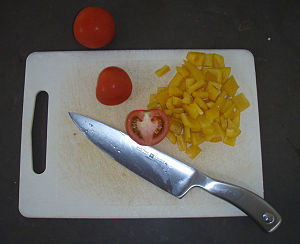 |
| Plastic cutting board (Photo credit: Wikipedia) |
If you're like me you have at least one plastic cutting board in your kitchen. I love that I can toss it in the dishwasher and it comes out clean right? Apparently not so!
 |
| A wooden chopping board (Photo credit: Wikipedia) |
My mother has always preferred wooden boards for making bread dough, but not for messy foods. However, several articles I found state that the cellular structure of wooden cutting boards actually wick the bacteria to a centimeter or so under the surface of the wood, thus reducing the bacteria on the surface that might transfer to other food. You can find a good summary of these (and other kitchen bacterial haunts here).
Wood is better than plastic especially when the surface gets nicked by a knife or two. Plastic cutting boards with knife nicks have bacteria present in those cuts even after washing!
If you want to try out a wooden cutting board, you need to know a couple things. Pine and ash were shown to have the best anti-microbial properties of the woods tested. Some woods were no different from plastic in bacterial contamination. For cleaning, I've been told not to use soap on unsealed wood as it (like the bacteria) gets into the wood making food taste soapy. Also, the same properties that make wood antimicrobial can break down bleach, making it ineffective as a wood cleaner. What does work, is getting the wood wet and then microwaving it for about 5-10 minutes. Crazy but cool!
I'll be consider a wooden cutting board soon. How about you?

No comments:
Post a Comment